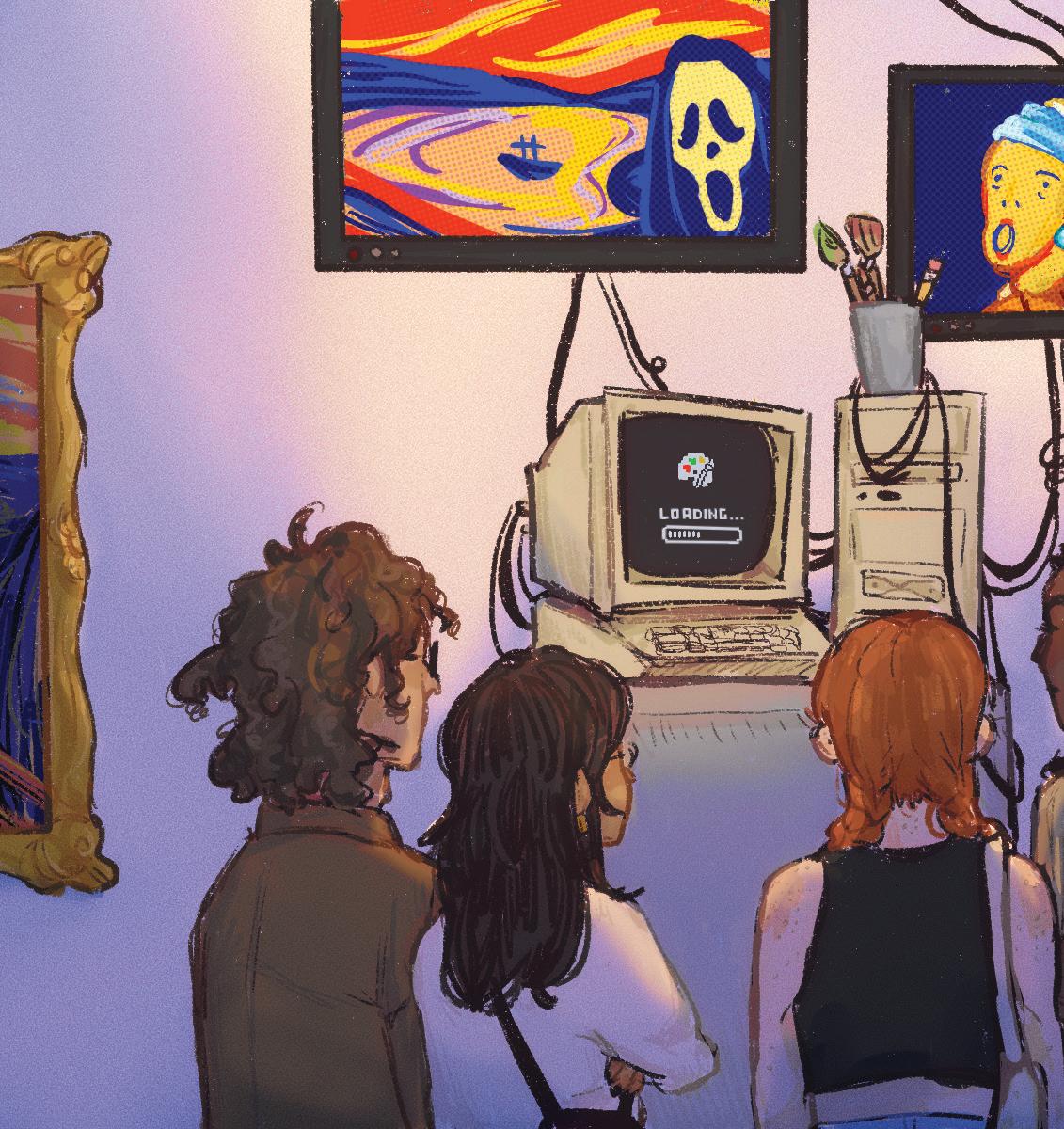

COLUMBIA SCIENCE REVIEW Volume 19 Issue I SPRING/FALL 2022
Search for your new role quickly by discipline, country, salary and more on naturecareers.com









A97909
Develop your scientific career with our support
Fair Use Notice
Columbia Science Review is a student publication. The opinions represented are those of the writers. Columbia University is not responsible for the accuracy and contents of Columbia Science Review and is not liable for any claibased on the contents or views expressed herein. All editorial decisions regarding grammar, content, and layout are made by the Editorial Board. All queries and complaints should be directed to the Editor-in-Chief.
This publication contains or may contain copyrighted material, the use of which has not always been speci cally authorized by the copyright owner. We are making such material available in our e orts to advance understanding of issues of scienti c signi cance. We believe this constitutes a “fair use” of any such copyrighted material, as provided for in section 107 of the US Copyright Law. In accordance with Title 17 U.S.C. Section 107, this publication is distributed without pro t for research and educational purposes. If you wish to use copyrighted material from this publication for purposes of your own that go beyond “fair use,” you must obtain permission from the copyright owner.
Cover illustrated by Tiffany Qian
BOARD CO-EDITOR-IN-CHIEF EMILY SUN MANAGING EDITOR NINA LILOIA CHIEF DESIGN OFFICER ALEXANDRA COCHON CREATIVE CHAIR SARAH SANZEBIN WRITERS RACHEL LEE, ANGEL LATT, ANUVA BANWASI, ISABELA TELLEZ, JENNA EVERARD, JIANNA MARTINEZ, JULIA GORALSKY, LAUREN GORALSKY, LAYA GOLLAMUDI, JULIETTE SHANG, AIDAN EICHMAN, TATA TIRAPONGPRASERT, DAVID CHANG, RAMYA SUBRAMANIAN, SYLVIE OLDEMAN, THILINA BALASOORIYA, NICHOLAS DJEDJOS, NICHOLAS LOFASO, MARIA VELERIO ROA, DANIEL SHNEIDER, NOAH WOHLSTADTER, CHARLES BONKOWSKY CO-EDITOR-IN-CHIEF AIDA RAZAVILAR DIRECTOR OF LOGISTICS AMANDA LEONE CHIEF ILLUSTRATOR YASSINE ABAAKIL ILLUSTRATORS ALICE WANG, ELIZABETH TORNA, KENDALL DOWNEND, SREOSHI SARKAR, TIFFANY QIAN, YI QU, AUDREY ACKEN, CINDY JIN, JULIAN MICHAUD, LUANA LIAO, NINA KORNFELD, ANDRE ANDONNINO, ARUNA DAS, SUMMER RENCK LAYOUT DESIGNERS MONICA RIVERA, YASSINE ABAAKIL, ALEXANDRA COCHON EDITORS AMANDA PENG, EDWARD KIM, JIMMY ZHANG, NICHOLAS TAN, PRIYA RAY, SARAH BOYD, SHIVANI TRIPATHI, VANESSA YANG, ASHLEY GARCIA, KEVIN ZHANG, TREY PURVES, CADEN LIN, KYRA KRISHNA EXECUTIVE BOARD PRESIDENT JOSH YU SECRETARY RANGER KUANG PR CHAIR SONALI DASARI SENIOR OCM ELLA SAFFRAN OCMs EMILIYA AKHUNDOVA, KATHERINE WU, MIRIAM AZIZ, EMILY SARKAR, ASHLEY HOUSE, PORTIA CUMMINGS, PRISCILLA CASTRO, SOLE TESFAYE, GREG TAN, OSHMITA GOLAM, LYNN NGUYEN VICE PRESIDENT FARIHAH CHOWDURY TREASURER BRIAN CHEN MEDIA CHAIR LUKE LLAURADO OCMS JENESIS WILLIAMS, KARSHISH KUMAR, MIRACLE ST. KITTS, SASHA MAMAYSKY, ZARYAAB KHAN, ZEKE JOHNSON, ANDREW CHUN, PRANAY TALLA SENIOR ADVISORS HANNAH LIN, AROOBA AHMED The Executive Board represents the Columbia Science Review as an ABC-recognized Category B student organization at Columbia University.
EDITORIAL
table of contents 06 10 13 15 18 20 22 25 28 LETTERS FROM THE EDITORS NEWLY-APPROVED BREAST CANCER TREATMENT CAUSES HOPE BACTERIAL ART ELECTRICALLY CHARGED FASHION A PROMISING WEB OF EXOPLANET DISCOVERIES THE FRIENDSHIP PARADOX SPACE AS THE OCEAN THE SCIENCE OF LASERS ARE WE ALONE? THE DARK FOREST HYPOTHESIS
letters from THE EDITORS

Dear Reader,
Hi there! Welcome to the Columbia Science Review’s Spring/Fall 2022 print issue. Consistent with our mission of increasing scientifc engagement and literacy, you will fnd this issue features captivating topics in various disciplines.
As you browse through this edition, you will stumble upon articles that investigate energy harvesting through fashion, show how bacteria can be repurposed for art, and discuss novel breast cancer therapeutics. You will travel through deep space, learning about the scientifc importance of friends and laser beams. These topics may be complex, but rest assured that our writers do an impressive job of breaking them down into digestible pieces.
This marks the sixth issue that the Columbia Science Review has released during the pandemic. Amidst these challenges, we truly owe it to our dedicated team of writers, editors, illustrators, layout designers, and core members, who have put in tremendous efforts to realize this vision. They are the heart and soul behind this issue. I want to thank everyone for taking the time to be a part of our team.
As we navigate the pandemic and adjust to a new normal, science continues to present itself in frequently daunting ways. I hope that through these articles, you are reminded of the enduring excitement, hope, and joy that science is capable of providing. Enjoy!
With love,
Emily Sun Co-Editor-in-Chief

www
6
Dear Reader,
Welcome to the incredible 2022 Issue of the Columbia Science Review! In this issue, we take on a host of different topics from how the number of friends your friends have can help inform future pandemic preparedness protocols to applying game theory for understanding the utility of the search for life beyond earth. Wherever your interests lie we have something in store for you!
As the past few years have been, full of starts and stops, it can be hard to (re)invigorate a shared sense of community; however, I am incredibly grateful for the opportunity to bring back and also create a new vision for CSR’s Editorial publication team. Speaking to each of the students on this team I appreciate the privilege of getting to work with such multidimensional and multi-talented individuals whose collective efforts and work, I hope, is able to come across in our latest issue. Though this issue is far beyond the sum of its parts, each of those parts and the passion of the people on this team has made it into something truly spectacular.
I want to thank you for taking time out of your day to read and sit with some of the work our team has put together. Behind each of these articles are writers, editors, illustrators, layout designers who I know are so excited to see someone (that someone looking down on this page now) connecting with their work in whatever way that may be. If one of these articles or illustrations resonated with you, please reach out to us and we would love to relay it to them! It makes it so much more worthwhile when you can see that something you’ve created clicked with another in some way. It is a motivating force to keep creating and keep showing your work. I hope that speaks to an important sentiment and love of science that binds us: a general spirit of innovation and love for sharing that knowledge with others. How ever these articles teach you a new fun fact or change the way you think we would love to hear!

Best wishes,
Aida Razavilar Co-Editor-in-Chief

7
Dear Reader,
Welcome to the Fall 2022 Print Issue!
I am grateful to have worked with the group of enthusiastic and passionate writers, editors, illustrators, and layout designers of CSR this semester. Communicating science in an accessible way is one of the key missions of CSR. No matter your background in or experience with science, the skill of CSR’s staff will make the scientifc concepts explored in our articles enjoyable and easy to understand.
CSR’s publications remind us that science is not confned to stuffy laboratories, expensive textbooks, and classroom whiteboards, but is an important part of our daily lives. It allows us to improve our vision, live longer, and prevent pandemics. It helps us preserve our planet’s resources. It inspires us to make to make beautiful and unique artwork (all examples of topics explored in this issue!). Science is in everything, and for everyone.
In reading this issue, we hope you have fun, learn something new, and keep asking questions. Learning more about what others are exploring and discovering can be a great way to determine what problems you want to tackle in your own life and work, or to challenge yourself to rethink what you already know.
The world faces many daunting challenges, and I often hear students like myself express that they feel overwhelmed, or that issues feel too big to tackle. But along with problems come opportunities for discovery, creativity, and innovation. In the words of Marie Curie, “Nothing in life is to be feared, it is only to be understood. Now is the time to understand more, so that we may fear less.” Here at CSR, we hope to help you understand more and to inspire you to view challenges not with fear, but with curiosity and possibility.
Sincerely,
Nina Liloia Managing Editor

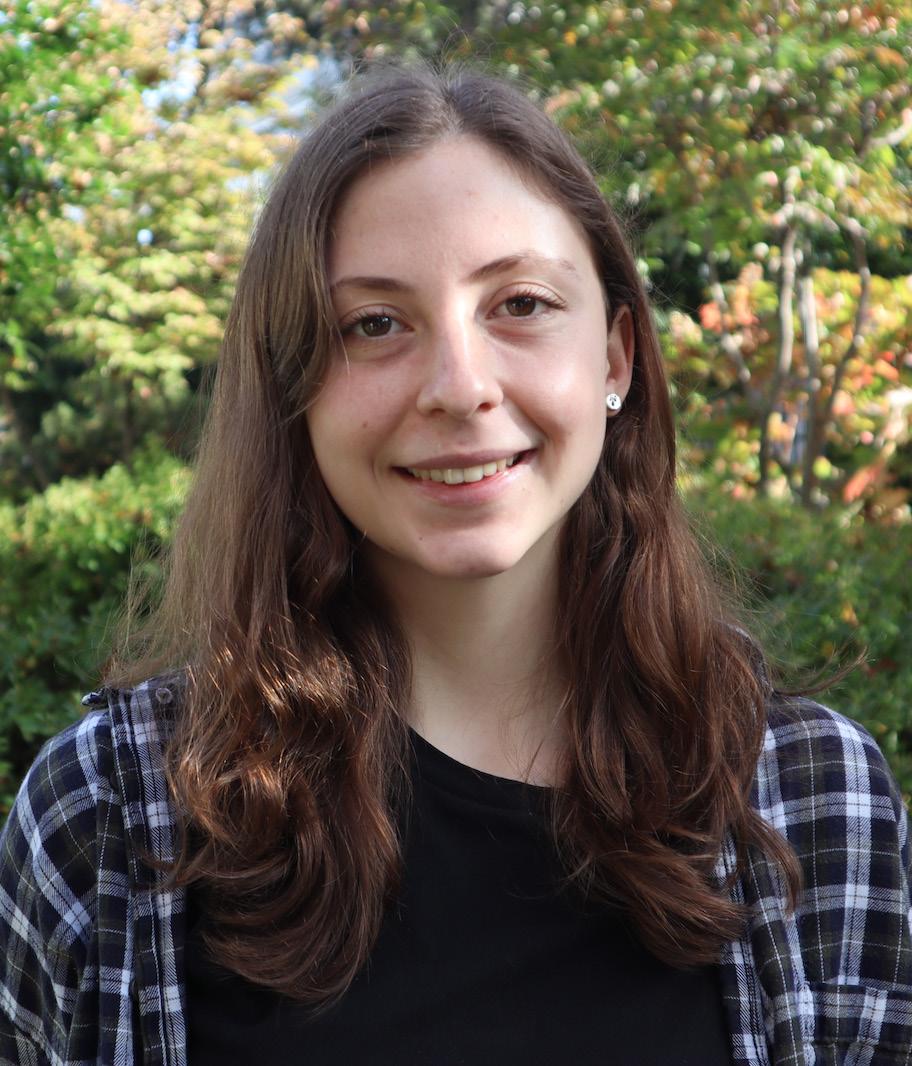
8
WELCOME TO THE SPRING/FALL 2022 EDITION
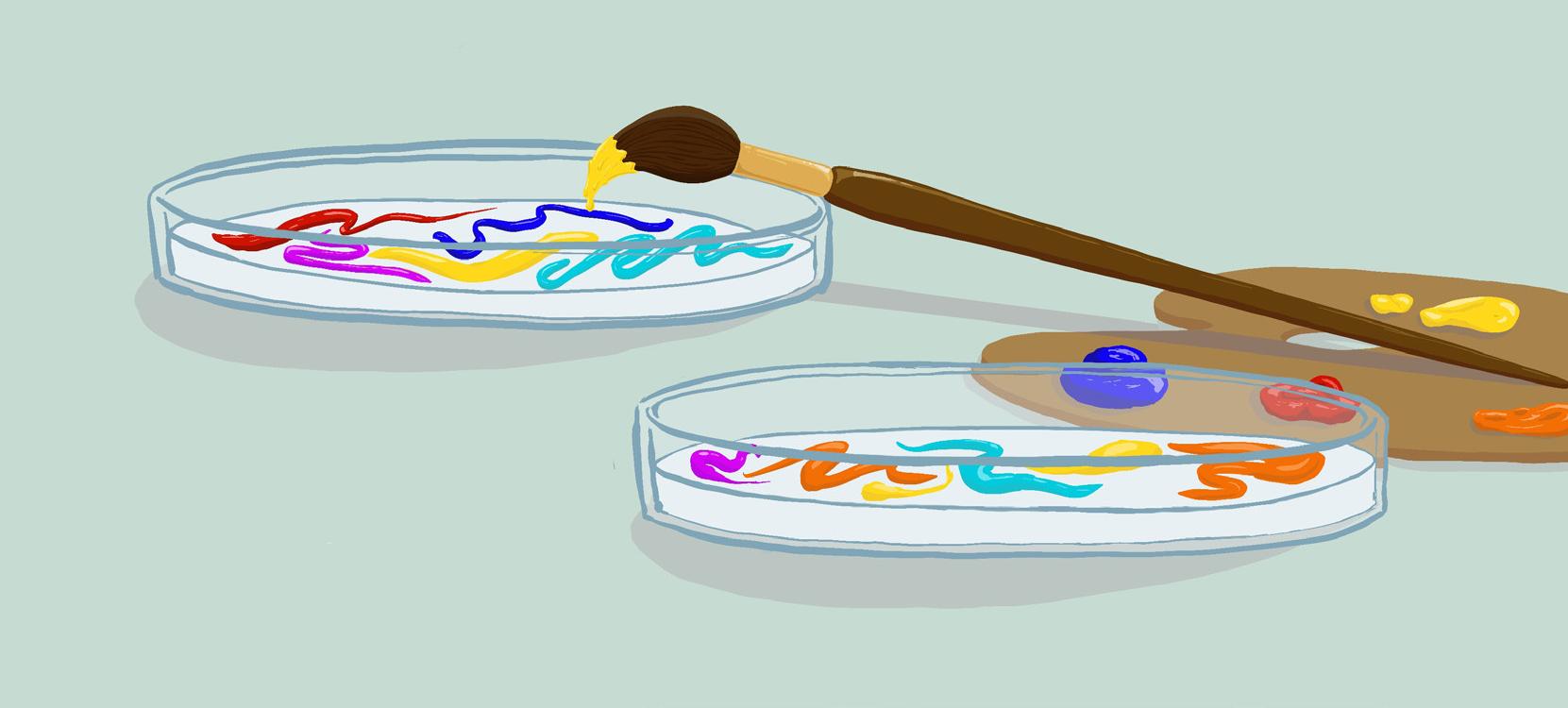







NEWLY-APPROVED CANCER TREATMENT CREATES
Breast cancer is one of the most common types of cancer in women, making up ~1/3 of all new cancer cases in women every year in the United States [1]. While there are many different types, roughly 50-60% are considered HER2-low, which means that there’s a very low amount of the HER2 protein in that specifc case of cancer [2]. HER2low cancers, while typically less aggressive, had fewer treatment options than HER2-positive cancers. However, a new treatment option was recently approved that will change the lives of HER2-low patients.
HER2 is a human protein encoded for by an oncogene, or a gene that has the potential to become cancerous. Functionally, this protein is a membrane receptor and vital part of a complex pathway that ultimately leads to cancer cell proliferation, essentially acting as a growth aid to the can-
cer cells. When present in high amounts in breast cancers, the cancer is considered HER2-positive and accounts for around 20% of all breast cancers [3].
While being HER2-positive means that the cancer is typically more aggressive, scientists have also focused on developing HER2-positive cancer treatments, and extremely effective treatments for the HER2 protein and pathway already exist. One of these treatments is Trastuzumab, a drug approved by the FDA in 1998 that targets the HER2 receptor to prevent it from overexpressing cancer cells [4].

When used to treat both non-metastatic and metastatic (indicating whether it’s spread to other parts of the body or not) HER2-positive breast cancers, Trastuzumab is incredibly effective. It’s often used in combination with
Illustrated by Julian Michaud

10
NEWLY-APPROVED BREAST CREATES NEW HOPE
chemotherapy, vastly improving outcomes for patients with HER2-positive breast cancer of any stage [5]. Since it specifcally targets the HER2 protein, however, it hasn’t been very effective in treating HER2-low breast cancers.
However, in August 2022, a groundbreaking new HER2low treatment emerged.
On August 5, 2022, the FDA approved a modifed Trastuzumab treatment for use in HER2-low breast cancers. In particular, the treatment focuses on metastatic and non-operable forms of HER2-low cancer, since those are the ones that have some of the worst outcomes and are the hardest to treat with more traditional methods. It combines the base Trastuzumab drug with chemotherapy, allowing for targeted delivery and more effcient treatment. This treatment is known as T-DXd, or by its brand name of Enhertu, and it is the frst FDA-approved targeted therapy for HER2low breast cancer [6].
This represents a breakthrough in treatment options for patients with either of these subtypes of cancer. HER2-positive breast cancers have had treatment options like non-modifed Trastuzumab for years, and HER2-negative breast cancer patients did not have the same issue of more rapid cell proliferation that patients with the HER2 gene have. HER2-low cancers don’t have enough protein to be a target for regular Trastuzumab, yet still have enough protein for it to be an issue. This means that there was a clear need for new treatment options for these subtypes of breast cancer, especially those that are non-operable or metastatic; these patients either don’t respond or respond poorly to the more traditional treatment methods, contributing to their poor prognosis and abruptly ending countless lives every year.
Enhertu was approved for use in HER2-low cancer types based on the results of a clinical trial conducted at Memorial Sloan Kettering Cancer Center in New York City. Dr. Shanu Modi, the principal investigator (PI) of the study, was also the frst author of the study that led to the original FDA approval of Enhertu in 2019 for patients with HER2-positive breast cancer who were no longer responding to other treatment options. The trial was conducted from 2018 to 2021 and involved 557 patients who were placed into two groups [7]: those who received the Enhertu treatment laid out by Dr. Modi and her team, and those who received chemotherapy as prescribed by their own oncologists according to typical treatment regimens.
Written by Nicholas Lofaso
Overall survival for patients in the trial was 23.4 months for those in the Enhertu group and 16.8 months for those in the oncologists’ choice group. The Enhertu group outperformed the traditional group in nearly every sense, with almost no adverse effects compared to the traditional group. Considering that all of these patients had poor prognoses to begin with, this addition of about 7 months to their lifespan is a major deal, allowing them to live longer and spend more time with their loved ones.
Still, overall survival only tells part of the story. Patients dealing with terminal illnesses often become sicker as time goes on, restricting their ability to live even semi-normal lives. Often becoming bed-bound or too ill to go about their daily lives, the amount of time that they live is generally not as important of a metric as the amount of quality time that they have before becoming too sick to enjoy it.
In this sense, the Enhertu treatment is even more profound. It showed a progression-free survival of 9.9 months on average, compared to the oncologists’ choice treatment average of 5.1 months. This represents a nearly 100% increase in the amount of time that they had without their disease getting worse, vastly improving their quality of life and maximizing the amount of time they could spend doing the things they enjoy.
Adverse events, or unexpected medical problems that occur during treatment, were a concern in this study as well, but they proved to not be much of an issue, if one at all. Adverse events of grade 3 or higher, which signify issues that require hospitalization but don’t represent an immediate threat to someone’s life, were observed in 52.6% of the Enhertu patients and 67.4% of the oncologists’ choice patients. Many of these events were the same as those that are often seen in traditional chemotherapy regimens, including neuropathy and cardiac issues.
Looking at the above data in a vacuum, it might not seem to be as big of a deal as it is; these patients’ diseases are still terminal, and they’re still staring down death. Context is everything, though, and it’s extremely important to remember just how dire the situation was here before this treatment was approved.
There’s no better example of this than Allison, who was part of the New York City clinical trial in the Enhertu group. She was diagnosed with stage 4 breast cancer nine years ago, and went on MSK’s Cancer Straight Talk podcast to

11
discuss her experience with the drug.
““For me, it’s been wonderful to be on the same drug for that long,” she said. “To feel hopeful, to have more time to live, to work, to spend time with family and friends and do the things that are important to me. And to do it all with mild side e ects, I’m just really grateful to be on this drug and to be feeling really good.”
While Enhertu is currently only FDA-approved for use in breast cancer and some other very specifc types of cancer, researchers like Dr. Modi hope to use it and drugs like it to target other cancers. Targeting cell-specifc receptors in combination with chemotherapy, like Enhertu does, presents an entirely new way of treating cancer, especially those that previously had poor outcomes. This does not mean, however, that the battle is over yet; this is still just an improvement in outcome, and not the cure that many people hope will one day exist.
REFERENCES

[1] Breast Cancer: Statistics. (2022, January). Cancer.Net. Retrieved from https://www.cancer.net/ cancer-types/breast-cancer/statistics.

[2] Enhertu Improves Survival for Metastatic “HER2Low” Breast Cancer. (2022, July 05). NCI – National Cancer Institute. Retrieved from https://www.cancer.gov/news-events/cancer-currents-blog/2022/ enhertu-her2-low-breast-cancer#:~:text=What%20 is%20HER2%2Dlow%20breast,60%25%20of%20 all%20breast%20cancers.
[3] Gutierrez, C. & Schiff, R. (2011). HER2: Biology, Detection, and Clinical Implications. Archives of Pathology and Laboratory Medicine, Vol.135(1), 5562. https://doi.org/10.5858/2010-0454-RAR.1.
”[4] Herceptin FDA Approval History. (n.d.). Drugs. com. Retrieved from https://www.drugs.com/history/herceptin.html.
[5] Herceptin: Biotechnology Breakthrough In Breast Cancer Wins FDA Approval. (1998, September 25). Drugs.com. Retrieved from https://www.drugs. com/newdrugs/herceptin-biotechnology-breakthrough-breast-cancer-wins-fda-approval-4878.html.
[6] FDA Approves First Targeted Therapy for HER2-Low Breast Cancer. (2022, August 05). FDA – U.S. Food & Drug Administration. Retrieved from https://www.fda.gov/news-events/press-announcements/fda-approves-first-targeted-therapy-her2-low-breast-cancer#:~:text=HER2%2Dnegative%20includes%20hormone%20receptor,be%20 classifed%20as%20HER2%2Dpositive..
““[We] recognize that curing stage 4 breast cancer has still eluded us,” Dr. Modi said on the same podcast. “But we recognize that this is one step closer to that. That’s always our goal;
[7] Modi, S. et. al. (2022, July 07). Trastuzumab Deruxtecan in Previously Treated HER2-Low Advanced Breast Cancer. The New England Journal of Medicine, Vol.387(1), 9-20. DOI: 10.1056/NE-
” 12
bacterial art
Written by Sylvie Oldeman
There is no question that nature can assume breathtaking forms. People travel from around the world to see the Northern Lights, the Grand Canyon, and the Great Barrier Reef. Yet, there is another beautiful form of scientifc art which can be accessed from anywhere on the Earth. In fact, it coats the body of every single person. Bacteria – microorganisms that form an intricate invisible layer enveloping the surfaces of our bodies – can be used as a medium for art in unexpected ways.
In the creation of bacterial art, bacteria of various colors are applied, as paint would be spread upon a canvas, onto plates of agar, a gelatin-like substance containing nutrients for their growth. Of course, the creative process is a bit more complicated when the tool is a live organism.

Scientist-artist Mehmet Berkmen explained that a few other factors must be considered in such an artistic endeavor: different bacteria possess distinct growth rates, ideal growth temperatures, and timing for expression of colors. Another element to consider is the population dynamics between different types of bacteria added to a plate. Chemical signaling and antibiotic secretion can alter the growth patterns and colors of nearby bacteria types, causing certain types to grow toward or away from each other. A fnal topic of consideration is that, like all living things, the bacteria will eventually die, causing dehydration and fading of colors. Ultimately, when the paint is alive and operates with a mind of its own, the product is rarely exactly as the artist anticipated.
Berkmen described his motivation in this feld as a desire to bridge two distinct gaps. The frst, a general disconnection between art and science, reasoning that when the two are melded together, “it’s usually superfcial.” But such a genuine collaboration of art and science in the form of bacterial art illustrates their reliance on each other.
Secondly, Berkmen hopes to rid bacteria of its negative reputation in the general public. Although typically discussed in relation to disease, only about 1% of all bacterial species are pathogenic, meaning the vast majority of bacteria are harmless to humans. As Berkmen would describe it, “we are just vessels of bacteria, and they rule this planet.”
Surrounded by a family of scientists, Berkmen has always been fascinated by biology. Yet, when he began his scientifc career, he felt pressure to abandon another passion: art. Eventually, after becoming the head of a lab at New England Biolabs, Berkmen reincorporated art into his life, beginning to create pieces of bacterial art. Despite his interest in this work, he still felt that there was not enough time to thoroughly blend these two interests; he was in need of an artistic collaborator.
Maria Peñil Cobo is an artist from a small fshing town in Spain, who has always expressed her connections to nature through art. Berkmen discovered Peñil through an exhibition of her art at a local restaurant. He was immediately drawn to her work, which Peñil characterizes as “pieces of art related to patterns and structures found in nature, organic and primitive shapes that make the observer uncomfortable and warm at the same time.” Once she entered the lab, Peñil quickly became fascinated by human biology at the microscopic level.
Since the beginning of their partnership more than a decade ago, Berkmen and Peñil have worked together to craft many pieces of bacterial art. Although their 2D pieces in plates of agar are quite impressive, the two were eager to expand to 3-dimensional work. One example of this 3D work was made using a mold of a face, allowing a piece that demonstrates the diversity of microorganisms that inhabit the external human body. Berkmen added that
13
Illustrated by Elizabeth Torna
Berkmen added that he has aspirations of making a fullbody piece. The two have also created time lapse videos, depicting the development of various pieces over time.
When organisms such as bacteria are grown in a laboratory, scientists typically avoid contamination at all costs. Although it is not typically exciting for an experiment to be ruined by a mysterious growth, Berkmen and Peñil have gained an appreciation for these adoringly-named unexpected “guests.” Berkmen explains that if the new arrival has an interesting color or shape, they “make sure that it’s nothing scary and then [they] play with it,” incorporating it into a new piece of art.
When Berkmen and Peñil began introducing their pieces in museums and other public spaces, a method of preservation was needed. They eventually settled on using epoxy, a resin which hardens clear and is air-permeable, enabling bacteria to continue growing even after the piece has been sealed – a dynamic product.
Peñil draws artistic inspiration from many different sources. Many of her pieces, (which can be viewed at bacterialart. com), employ bacteria to portray a specifc illustration of subjects such as animals and human tissues. Additionally, because she works with bacteria, Peñil explained that her own body and the bodies of others are of particular relevance and interest. Thus, she also uses the bacteria itself as inspiration, creating pieces inspired by the source of the bacteria used to make it.
One particularly memorable piece of such meta inspiration is titled “Collective Thoughts.” Although the purpose of the piece was not revealed to Berkmen until its completion, Peñil explained that she “was trying to collect the bacteria of the four scientists and [herself] working and thinking together in the space where [they] all create.” She believes that collaboration with others in the lab is essential for the production of her art, and, by collecting the bacteria of their shared space, she was able to visually capture this intangible collaboration.
A second interesting piece of bacterial art, which also found its inspiration from the bacteria used to create it, is called “Sustenance.” To create this piece, which represents the “connection and microbial communication between [Peñil] and her daughter within [her] womb,” Peñil isolated bacteria from her nipples while breastfeeding as well as from her daughter’s belly button. Then, she used these meaningful microbial samples to depict a connection between a mother’s breast and the fetus in the womb.

Berkmen and Peñil have achieved great success in the realm of bacterial art, winning a 2015 agar art competition. Their art is widely appreciated, and they have plans to expand their contributions through this medium. Berkmen frequently delivers talks about his work, and the two also provide interactive educational sessions in which they guide students in the creation of their own bacterial art.
Although the partnership between Berkmen and Peñil has been suspended due to the pandemic, both are eagerly anticipating the opportunity to resume their work together. Once Peñil is able to return to the lab, she hopes to continue work on exploring interactions between bacteria, delve further into the possibilities of 3-dimensional bacterial art, and potentially expand her microbial palette to other microorganisms, such as fungi.
In addition to these contributions to greater society, the pair’s bacterial art has also enabled tangible progress within the feld of microbiology.
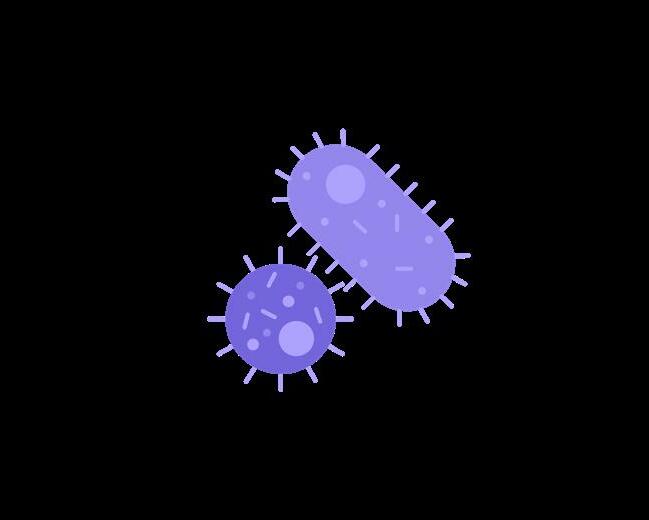

Incidentally, in the process of designing a device to use in making their time lapse videos, Berkmen addressed problems including dehydration of the agar medium and the effects of sunlight during growth. The result was a chamber sealed in black with a humidifer and water supply. In addition to its successful use as a time lapse video device, this chamber offered a signifcant contribution to the study of bacteria.
Berkmen explained that although bacteria have been studied for hundreds of years, they have always been observed through a microscope, in the micrometer scale (1 micrometer = 1/10,000th of a centimeter). The device held promising value for microbiologists studying the growth of bacterial colonies and was published as a new method in a well-renowned, peer-reviewed scientifc journal.
The tight interconnectedness of science and art through bacterial art is inspiring. It offers the promise of a future in which science and art rely more substantially on one another to improve both felds, and, subsequently, society as a whole.
Note: All quoted material in this article was obtained from author’s personal interviews with Berkmen and Peñil.
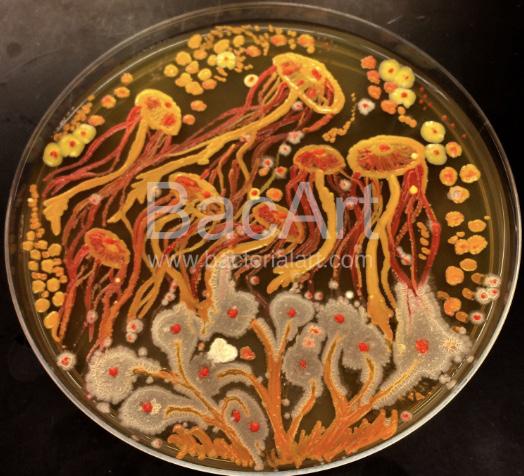
14
ELECTRICALLY CHARGED FASHION
Written by Lauren Goralsky Illustrated by Tifany Qian

the new solution to our energy crisis
15
New York City is known for its fashion, models, luxury, and most of all, never turning the lights off. In fact, the inability to fick the off-switch has given NYC the title of “Most Wasteful Megacity,” [1] with its energy usage even surpassing that of the world’s largest megacity, Tokyo, which hosts an additional 26 million people [2]. For anyone who has had the privilege (or horror) of seeing Times Square, with its dominating screens shining through the night, this news can hardly come as a surprise. The continual activation of ineffcient electrical circuits powering each screen not only leads to the extensive use of electricity, but generates “electrical waste,” or energy which cannot be used in a productive capacity. Perhaps more terrifying, this excessive generation of electrical waste is not unique to NYC, but rather common to the U.S., which consumes 17% of globally available energy despite having only 4% of the world’s population.
Should we be worried about the extensive usage of energy? To answer this question, we must frst take a look at the laws of thermodynamics. The frst law of thermodynamics states that energy is conserved, indicating that it can never be created or destroyed. However, while energy can never be lost, the second law of thermodynamics states that every time this energy is transferred, or “used,” it is converted into a thermal form which cannot be utilized to produce any more useful work. Therefore, everytime electrical energy is used in powering an ineffcient circuit to light the screens in Times Square, which additionally contributes to energy waste, more energy is rendered unusable. Furthermore, fossil fuel-based resources used to generate and harness energy are limited, and existing reserves of coal and oil continue to be harvested at expeditious rates [3]. Furthermore, despite the promise of renewable energy sources, there are signifcant, negative environmental impacts associated with these methods of obtaining energy, such as, for example, the disruption of wildlife and habitats [4]. Therefore, understanding the fnite nature of energy resources as well as ineffciencies used in harnessing energy should give you a healthy dose of fear considering most modern day commodities–cell phones, refrigerators, air conditioners–all need electrical energy to function.
For decades, scientists and engineers have looked for ways to limit energy waste, including the creation of energy-effcient appliances and LED light bulbs. While these solutions have proven successful, new studies demonstrate the effectiveness of energy generation in creating new fashion trends. Scientists from the University of Surrey have developed an accessory made of recycled materials that can be used to harvest energy [5]. Specifcally, this wrist device is made of paper wipes and plastic cups, and runs on the energy produced from the movement of the wearer. This device is powered by the use of surface charges (or the movement of charges (+/-) to the exterior plane of an
object/person) and depends upon the principle that with contact, objects can become electrically charged. Therefore, static charge can be harvested by specifc forms of material (triboelectric nanogenerators) to generate energy through electrostatic induction, which refers to the redistribution of charges on one object by the introduction of other charged species. While scientists have yet to release specifc design plans, their new research suggests that this technology will most immediately be applied to smart watches. This suggests less dependence on wasteful or ineffcient circuits traditionally used in the translation of energy and instead displays a more succinct translation of energy to be utilized. Unlike most of the screens in Times Square, these watches won’t depend on traditional, ineffcient electric circuits and the burning of fossil fuels and will instead utilize the natural movement of humans.
A fashionable watch is just one piece of this technological puzzle. While the energy produced from the motion of one human may not be suffcient enough to power all of the screens in Times Square, this new device suggests energy can be obtained more sustainably, decreasing a portion of controllable electrical energy waste that results from circuit ineffciencies. In continuing to support energy effciency research, we ensure that energy is available for future generations and that the lights and glamor of NYC last for a bit longer.
16
references

[1] As quantitatively based on data collected by Kennedy, Christopher A, et al. “Energy and Material Flows of Megacities.” PNAS, vol. 112, no. 9, 27 Apr. 2015, https://doi.org/https://doi.org/10.1073/ pnas.1504315112.
[2] “World City Populations 2022.” World Population Review, https://worldpopulationreview.com/world-cities.
[3] “U.S. Coal Reserves.” U.S. Energy Information Administration (EIA), 2021. https://www.eia.gov/ coal/reserves/
[4] “Environmental Impacts of Renewable Energy Technologies” Union of Concerned Scientists, 2008. https://www.ucsusa.org/resources/environmental-impacts-renewable-energy-technologies
[5] “Surrey Unveils Energy-Harvesting Wearable Device Made from Recycled Waste.” Surrey Unveils Energy-Harvesting Wearable Device Made from Recycled Waste | University of Surrey, https://www. surrey.ac.uk/news/surrey-unveils-energy-harvesting-wearable-device-made-recycled -waste.
17
A PROMISING WEBB OF EXOPLANET

planet candidate, GJ 2512 b, is too large compared to its star to have formed via core accretion [5]. It instead supports the competing disk instability model, which proposes that some planets form from the sudden, inward collapse of dust clouds massive enough to exert their own gravity [4]. Today there is a middle ground where both theories may hold true, but we have yet to draw a defnitive line between them. The discovery of even more exoplanets would make it possible to map out the boundary conditions where one theory ends and another begins.
However, fnding an exoplanet is not as simple as spying it through a telescope. Exoplanets do not give off any light of their own, so astronomers need to detect them without seeing them directly. To achieve this goal, NASA launched the Kepler spacecraft, a notable predecessor to the JWST, into orbit in 2009 [6]. For four years, it continuously measured the amount of light from over half a million stars across our Milky Way. But rather than starlight, the telescope was searching for shadows — ones that would periodically ficker and bob across its feld of view — indicating that they were cast by orbiting exoplanets. These shadows, known as transits, occur due to the perceived dimming of a star when an exoplanet passes over it and partially blocks its light [7].
Images of the exoplanet HIP 65426b, taken from different wavelengths of infrared light. The white star represents the location of the exoplanet’s host star, which a coronagraph blocked out. [2]

A bright, white sphere lies at the center of a black canvas. Its hazy edges slowly dissolve into reddish embers before scattering through the darkness of space. This is an image of the frst exoplanet (a planet outside our solar system) photographed by NASA’s James Webb Space Telescope (JWST), a hexagonal array of gold-plated mirrors and other scientifc instruments launched into orbit around the sun just over ten months prior [1]. The four fltered images of the exoplanet, named HIP 65426 b, were released on September 1st, and they now represent the latest step in humanity’s ongoing search for life outside of Earth. Simply put, our search for life strives to answer curious questions about human existence. To fnd out how our home on Earth came to be and whether there are others like us in the universe, astronomers start with the alternate worlds of exoplanets [3]. Should they locate a near carbon copy of Earth, teeming with life, we could declare that we are not alone. If a candidate’s features are far from those of our “blue marble,” its unique properties would still help challenge and refne modern theories about planet populations.
For example, core accretion was the longstanding theory of planetary formation. This model proposes that planets are created from the collisions of tiny dust particles that clump together to form a larger mass [4]. No evidence within our solar system refutes this theory, but one exo-

The Kepler mission popularized this “transit method,” which can not only fnd undiscovered exoplanets but also determine their physical properties, such as size and orbital period, based on the shape of their transits [6]. The method spurred a jump in the number of confrmed exoplanets from a couple hundred to over 5000 — 60 of which are potentially habitable [8]. Despite this surge of data and discovery since the Kepler mission, much more evidence is still needed to obtain clear signs of life. In particular, we know relatively little about the chemical properties of exoplanet atmospheres.
This is exactly what the new-generation JWST hopes to reveal. To capture a direct image of an exoplanet, the telescope starts by turning its grid of mirrors towards its target, observing any nearby light. When light strikes the surface of the primary mirror, a thin layer of gold foil accurately focuses the light onto an opposite, smaller mirror [10]. The secondary mirror refects the light once again, directing it into the telescope’s scientifc instruments [10]. This raw light data is not very interpretive though, as trying to fnd the exoplanet would be like looking for “a frefy around a searchlight” against the overwhelming brightness of its host star [11]. Coronagraph technology can
18
EXOPLANET DISCOVERIES
theoretically mask out the excess glare coming from the star, but it requires an incredibly stable telescope design [12]. The powerful JWST spectrographs can then break down that light into a spectrum of wavelengths, similar to how sunlight splits into the colors of a rainbow. Analyzing the spectrum reveals the chemical composition of an exoplanet’s atmosphere. If any wavelengths are missing from a full spectrum, astronomers can trace them directly back to specifc chemicals that must have absorbed the missing wavelengths before they could reach the telescope [13]. Finding the classic Earth-like mixture of methane, carbon dioxide, and oxygen in an exoplanet’s atmosphere could signify that biological processes are at work [14]. Conversely, fnding a toxic brew of gaseous clouds likely indicates the absence of life. Described by scientists as a “warm, dusty” gas giant similar in composition to Jupiter and certainly uninhabitable by Earth standards, the newly analyzed HIP 65426 b seems to fall under the latter category [15].
As cutting-edge technology pushes JWST’s sensitivity to levels over 100 times greater than that of the Hubble telescope, astronomers are very optimistic about future detections [9]. Aarynn Carter, frst author of the soon-to-be-published paper on HIP 65426 b, points out that the telescope performed much better than expected: “previously we’ve been limited to detections of super-Jupiters, but now we have the potential to image objects similar to Uranus and Neptune for the right targets” [16, 17]. Among the JWST’s upcoming targets is TRAPPIST-1, a distant star already home to three potentially habitable planets [18]. While it is unknown if the JWST can reveal crucial details about their environments, it will still lay a solid foundation for future telescopes. As we engineer the sensitivity to image even smaller planets, perhaps they will no longer appear as just blobs of pixels in the mirrors of a telescope. In those mirrors, a lifelike refection of ourselves could slowly begin to take shape. Betting on the off-chance that the JWST does discover something big, it could be an early golden ticket to meeting the frst aliens in the cosmos.
Written by David Chang
REFERENCES
[1] NASA. (2022). Webb Space Telescope GSFC/NASA. NASA. Retrieved from https://webb.nasa.gov/.

[2] Image of Exoplanet HIP 65426 b in Near and Mid Infrared. Webb Space Telescope. (2022). Retrieved from https://webbtelescope.org/ contents/media/images/01GBT1E93YV7YND5MFS1603FWJ

[3] Brennan, P. (2019, November 19). Why Do Scientists Search for Exoplanets? Here Are 7 Reasons. NASA. Retrieved from https://exoplanets. nasa.gov/news/1610/why-do-scientists-search-for-exoplanets-here-are-7reasons/
[4] Matsuo, T., Shibai, H., Ootsubo, T., & Tamura, M. (2007). Planetary formation scenarios revisited: Core accretion versus disk instability. The Astrophysical Journal, 662(2), 1282–1292. https://doi. org/10.1086/517964
[5]
J.
(2019). A giant exoplanet orbiting a very-low-mass star challenges planet formation models. Science, 365(6460), 1441–1445. https://doi. org/10.1126/science.aax3198
[6] Johnson, M. (2015, April 14). Mission overview. NASA. Retrieved from https://www.nasa.gov/mission_pages/kepler/overview/index.html
Transit Method. Institute for Research on Exoplanets. (n.d.). Retrieved from http://www.exoplanetes.umontreal.ca/transit-method/?lang=en [8] NASA exoplanet archive. NASA Exoplanet Archive. (n.d.). Retrieved from https://exoplanetarchive.ipac.caltech.edu/ [9] European Space Agency. (2021, January 6). Comparing Webb and Hubble. ESA. Retrieved from https://www.esa.int/ESA_Multimedia/Images/2021/06/Comparing_Webb_and_Hubble
[10] Scarr, S., Chowdhury, J., & Sharma, M. (2021, December 23). Looking back in time. Reuters. Retrieved from https://graphics.reuters.com/ SPACE-EXPLORATION/TELESCOPE/klvyknwbrvg/
[11] O’Callaghan, J. (2022, September 2). Webb Space Telescope Snaps Its First Photo of an Exoplanet. uanta Magazine. Retrieved from https:// www.quantamagazine.org/webb-space-telescope-snaps-its-frst-photo-of-anexoplanet-20220901/
Leonard, D. (2022, September 22). JWST’s First Exoplanet Images
a Bright Future. Scientifc American. Retrieved from https:// www.scientifcamerican.com/article/jwsts-frst-exoplanet-images-fore
Morales,
C., Mustill, A. J., Ribas, I., Davies, M. B., Reiners, A., Bauer, F. F., Kossakowski, D., Herrero, E., Rodríguez, E., López-González, M. J., Rodr guez-L pez, C., Béjar, V. J., Gonz lez-Cuesta, L., Luque, R., Pallé, E., Perger, M., Baroch, D., Johansen, A., Klahr, H., Osorio, M. R.
[7]
C. T., Olson, S. L., Meadows, V. S., Cockell, C. S., Walker, S. I., Grenfell, J. L., Hegde, S., Rugheimer, S., Hu, R., & Lyons, T. W.
Exoplanet Biosignatures: A Review of Remotely Detectable Signs of Life. Astrobiology, 18(6), 663–708. https://doi.org/10.1089/ast.2017.1729 [15] Chauvin, G., Desidera, S., Lagrange, A.-M., Vigan, A., Gratton, R., Langlois, M., Bonnefoy, M., Beuzit, J.-L., Feldt, M., Mouillet, D., Meyer, M., Cheetham, A., Biller, B., Boccaletti, A., D’Orazi, V., Galicher, R., Hagelberg, J., Maire, A.-L., Mesa, D., Wahhaj, . (2017). Discovery of a warm, dusty giant planet around hip 65426. Astronomy & Astrophysics, 605. https://doi.org/10.1051/0004-6361/201731152 [16] Carter, A. L., Hinkley, S., Kammerer, J., Skemer, A., Biller, B. A., Leisenring, J. M., Millar-Blanchaer, M. A., Petrus, S., Stone, J. M., Ward-Duong, K., Wang, J. J., Girard, J. H., Hines, D. C., Perrin, M. D., Pueyo, L., Balmer, W. O., Bonavita, M., Bonnefoy, M., Chauvin, G., hang, . (2022). The JWST Early Release Science Program for Direct Observations of Exoplanetary Systems I: High Contrast Imaging of the Exoplanet HIP 65426 b from 2-16 m. arXiv. https://doi.org/10.48550/ arXiv.2208.14990 [17] Carter, J. (2022, September 2). Webb Telescope Makes Major Breakthrough With Its First Direct Image Of A Planet Outside Our Solar System. Forbes. Retrieved from https://www.forbes.com/sites/jamiecartereurope/2022/09/01/webb-telescope-makes-major-breakthrough-withits-frst-direct-image-of-a-planet-outside-our-solar-system/?sh=821e66a4b126 [18] Balmer, W. (2022, June 9). What might JWST reveal about TRAPPIST-1? The Planetary Society. Retrieved October 26, 2022, from https:// www.planetary.org/articles/james-webb-space-telescope-trappist-1
[12]
Forecast
cast-a-bright-future/ [13] Spectroscopy: Reading the Rainbow. HubbleSite. (2019). Retrieved from https://hubblesite.org/contents/articles/spectroscopy-reading-the-rainbow [14] Schwieterman, E. W., Kiang, N. Y., Parenteau, M. N., Harman, C. E., DasSarma, S., Fisher, T. M., Arney, G. N., Hartnett, H. E., Reinhard,
(2018).
19
Illustrated by Luana Liao

20
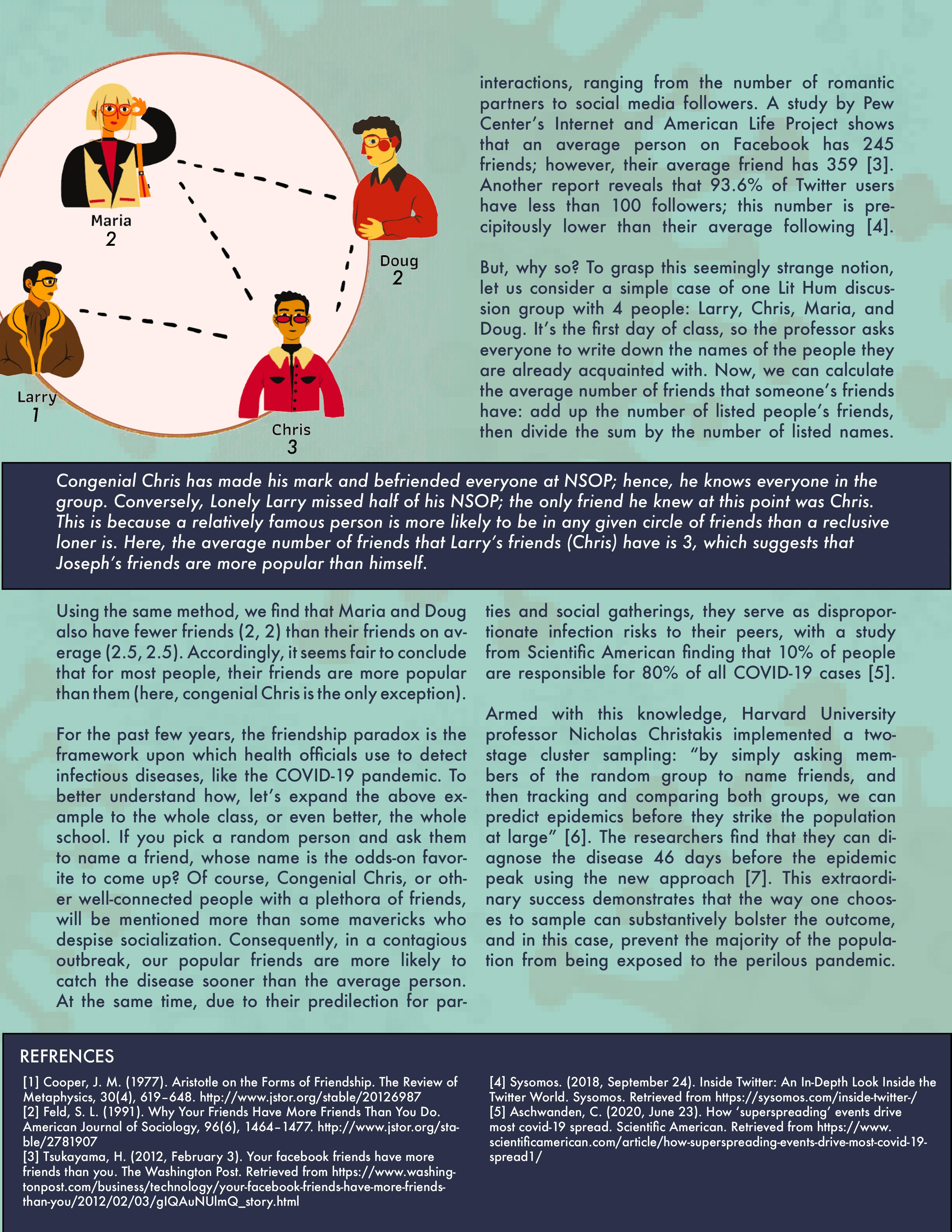
21

22

23

24
SPACE AS THE OCEAN

SF VISIONS OF SPACE TRAVEL
25
Written by Charlie Bonkowsky Illustrated by Sreoshi Sarkar
“We set sail on this new sea because there is new knowledge to be gained, and new rights to be won…and, therefore, as we set sail we ask God’s blessing on the most hazardous and dangerous and greatest adventure on which man has ever embarked.” (President John F. Kennedy, 1962) [1]
“As we once mapped the Earth in the wake of the Age of Discovery, we are now mapping the heavens, both in space and time.” (NASA Chief Historian Steven Dick, 2005) [2]
The earliest conceptions of space travel were hardly travel at all: space was merely that, intervening distance between one body and another, to be crossed in an instant like in Jules Verne’s From The Earth To The Moon [3] or H.G. Wells’ War of the Worlds [4]. And space was static, unchanging. In Wells’ The First Men in the Moon [5], one character dismisses the moon, declaring it “Dead—dead! Nothing happens. Men have watched this planet systematically with telescopes for over two hundred years. How much change do you think they have seen? None.” For these early science fction writers, the planets had been discovered for decades; space itself was cold, dead, and empty–both a literal and fgurative void.
But at the start of the 20th century, the universe began to open up. Newly powerful telescopes could pick out never-before-seen surface details on Mars (at frst wrongly interpreted as canals [6], signs of intelligent life) and, later, discover Pluto in the outer reaches of the solar system. The Milky Way became just one in a sea of galaxies in a much larger universe, opening up the prospect of space exploration, of strange new worlds suddenly within reach: a new Age of Discovery.
In 1928, the frst known space opera—The Skylark of Space, by Doc Smith—was published, marking the beginning of a genre of dramatic, interstellar-scale adventures in space [7]. Not realistic ones, by any stretch of the imagination; even today, space opera remains largely fantastical, featuring empires which span galaxies, faster-thanlight travel, intelligent alien civilizations, and more. But the creation of the genre marked a change in the way space was viewed in popular culture. The term “space opera” [8] isn’t derived explicitly from “opera”; instead, it began as a comparison to “soap operas,” or formulaic Western “horse operas.” In fact, several serialized space operas had their plots directly lifted from Westerns, as Galaxy Science Fiction magazine parodied [9]. A core facet of Western fction is the frontier, the ragged edge of civilization; confating the two, space inexorably became a frontier of exploration.
More down-to-Earth stories featured sleek, missile-like

rockets such as those in Fritz Lang’s The Woman in the Moon or Hergé’s Tintin: Destination Moon. Yet even these rockets, whose shape and power were sometimes consulted [10] by rocket scientists like Hermann Oberth, were still nowhere close to accurate. Until the 1950s and the advent of actual space travel, most fction drastically underestimated the amount of power it took to reach anywhere, least of all the Moon.
The sleek, needle-nosed, and altogether unrealistic rockets of Fritz Lang and Herge. At least they look pretty… [11] [12]

Then came the space programs of the 1950s and 1960s, in which people saw cosmonauts and astronauts travel into space for the frst time as well as the cramped, control-laden, often scorched and grimy capsules which carried them. Spacefight, at least within the Solar System, was “demystifed” [13]. But in fction, the idea of exploration remained, most iconically through Gene Roddenberry’s Star Trek (1966), and the mission of the Enterprise “to boldly go where no man has gone before.” And, for the frst time, this advent of exploration had moved into real-life space travel: it’s no accident that some of the most famous robotic explorers have borne the names of Mariner, Voyager, and Magellan.
But while some fction remained thematically fxed outwards on exploration, other authors grew dismayed at the end of the Apollo lunar-landing program and the retreat of human space exploration, introducing an air of disillusionment into the space fction of the 80s and 90s. Alongside this shift came a transition in the aesthetics of science fction: Star Wars, in flm, as well as the growing literary cyberpunk genre, introduced the concept of a “used future”: worn-down machinery and lived-in planets, which were a dramatic step away from the shiny, uniform chrome which had been the utopian vision of the future [14].
Now, after a long period of drought, human space travel is again beginning to take off. NASA hopes to return to
26
the Moon and continue from there to manned Mars missions [15]; likewise, innovations in private space travel like reusable boosters are driving down the barriers to reaching orbit. The realities and the possibilities of space travel are once again starting to capture the public imagination.
Sci-f is already changing in response. Some of the most popular books of recent years [16] have included Andy Weir’s The Martian and Project Hail Mary (imagining the trials of near-future astronauts) and Mary Robinette Kowal’s Lady Astronaut series (an alternate-history space race). A new Age of Discovery is upon us, these books say, with reinvented possibilities and reimagined pitfalls; what new stories will they tell?
REFERENCES
[1] JFK Library. (n.d.). Address at Rice University on the nation’s space effort, September 12, 1962. Retrieved from https://www.jfklibrary.org/archives/other-resources/john-f-kennedy-speeches/rice-university-19620912
[2] Dick, S. (2005, March 1). Voyages of Discovery NASA. Retrieved from https://www.nasa.gov/missions/ solarsystem/Why_We_08.html
[3] Verne, J. (1993). From the Earth to the Moon. Project Gutenberg.
[4] Wells, H. G. (2004). War of the Worlds. Project Gutenberg.
[5] Wells, H. G. (2004). First Men in the Moon. Project Gutenberg.
[6] Dunbar, B. (2009, April 13). The ‘Canali’ and the First Martians. NASA. Retrieved from https://www.nasa. gov/audience/forstudents/postsecondary/features/F_ Canali_and_First_Martians.html
Smith, E. E., & Garby, L. H. (2007). The Skylark of Space. Project Gutenberg.
[7] Fisher, K. (2021, July 15). Adventure Awaits: A brief history of space opera. Film School Rejects. Retrieved from https://flmschoolrejects.com/adventure-awaits-brief-history-space-opera/
[8] Cerutti, V. (1950, October). You’ll Never See It In Galaxy. Galaxy Magazine, 1(1), 163.
[9] Smithsonian Air and Space Museum. (n.d.). Woman in the moon/frau im mond. Pioneers of Flight. Retrieved from https://pioneersoffight.si.edu/content/womanmoonfrau-im-mond IMDb.com. (n.d.). Woman in the Moon. IMDb. Retrieved from https://www.imdb.com/title/tt0019901/
[10] Boyd, R. (n.d.). The Adventures of Tintin: Destination Moon. Slings & Arrows. Retrieved from https://theslingsandarrows.com/destination-moon/
[11] Space fight. Science Fiction Encyclopedia. (2022, October 3). Retrieved from https://sf-encyclopedia.com/ entry/space_fight
[12] Sherlock, B. (2021, March 20). The ‘used future’ of Star wars changed science fction. Game Rant. Retrieved from https://gamerant.com/star-wars-used-futurechanged-science-fction/
[13] NASA. (n.d.). Artemis. NASA. Retrieved from https://www.nasa.gov/specials/artemis/
[14] Hugo awards by Year. The Hugo Awards. (2022). Retrieved from https://www.thehugoawards.org/hugo-history/

27
by Julia Ann Goralsky Illustrated by Kate Steiner
What do James Bond, Jedi, and kids at a birthday party have in common? While this might sound like the start to a bad joke, each of these groups use lasers for various purposes whether it be for weapons of destruction, light sabers, or laser tag. Yet, what exactly is a laser?


“Laser” refers to light amplifcation by stimulated emission of radiation. Essentially, lasers emit a stream of photons which make up what we perceive as light. Yet, this light is different from what you would see coming out of a fashlight (thank goodness, otherwise fashlight tag might take on a whole new deadly meaning!). Specifcally, these beams of light are monochromatic, meaning that the ray of light possesses one wavelength. This is often why you see a colored laser beam, because each color is designated by a certain wavelength in the ultraviolet/visible light spectrum. Furthermore, lasers are in-phase and collimated beams. In other words, these characteristics refer to the alignment of the beam itself; in particular, individual waves are parallel to each other and positioned in a manner where the high and low points of one correspond to
the same respective regions of another. This leads to a phenomenon called constructive interference, where the amplitudes of the high points add together and the magnitudes of the low points combine [1].
Now that we’ve characterized the form of light associated with lasers, let’s take a look at their structure. Each laser has a lasing medium, which is composed of atoms. If you were to zoom in on the structure of these atoms, you would see particles called electrons orbiting each nucleus. When electrons absorb energy, they rise to energy levels farther away from the nucleus. Then, upon dropping back to lower energy levels, an electron releases energy in the form of a photon. Depending on the wavelength of the photon, the light emitted will be characterized by a spe-

28
Written
the same respective regions of another. This leads to a phenomenon called constructive interference, where the amplitudes of the high points add together and the magnitudes of the low points combine [1].
Now that we’ve characterized the form of light associated with lasers, let’s take a look at their structure. Each laser has a lasing medium, which is composed of atoms. If you were to zoom in on the structure of these atoms, you would see particles called electrons orbiting each nucleus. When electrons absorb energy, they rise to energy levels farther away from the nucleus. Then, upon dropping back to lower energy levels, an electron releases energy in the form of a photon. Depending on the wavelength of the photon, the light emitted will be characterized by a specifc color. This process is called stimulated emission [2]. Now that we understand how lasers work, it’s time to move onto what they can do. Outside Hollywood, lasers can be applied to a variety of (nonviolent) purposes. For example, take eye surgery. During procedures, lasers can be used to stop retinal hemorrhaging (perhaps better understood as internal bleeding within the eye). Furthermore, for those with vision impairments, lasers can reshape the cornea and center the incoming light onto the optimal “focal point” [3]. Lasers also play a prominent role in daily life. Every time you listen to a CD (or watch your older relatives enjoy this antiquated pastime), you’re relying on the use of lasers for the correct production and encoding of the CD. Furthermore, even the clothes you wear were likely derived from a production factory which uses laser cutters [4].
While these are all established uses of this awesome technology, new developments with lasers are never ceasing. At the beginning of last December, NASA launched the LCRD or the Laser Communications Relay Demonstration. The goal of this mission is to test communication via laser rather than radio waves. Scientists currently predict that up to 100 times more data can be sent via laser communications which could contribute to the necessary technology for deep space exploration. Currently, this technology is in its experimental phase, and over the next two years, this new system will be utilized for conveying information between the International Space Station and two ground stations in Hawaii and California [5].
As laser technology continues to develop in the upcoming years and even decades, the possibilities of its application are as extensive as the creativity of its innovators. Only, let’s just hope we avoid those death rays.

REFERENCES
[1]Characteristics of Laser Light. http://hyperphysics.phy-astr.gsu.edu/hbase/optmod/qualig.html#c5.
[2]Lawrence Livermore National Laboratory. How Lasers Work. https://lasers.llnl.gov/education/how_lasers_ work.
[3]Mayo Clinic. LASIK surgery: Is it right for you? https://www.mayoclinic.org/tests-procedures/ lasik-eye-surgery/in-depth/lasik-surgery/art 20045751.
[4]Laser Applications. http://hyperphysics.phy-astr.gsu.edu/hbase/optmod/lasapp.html#c1.

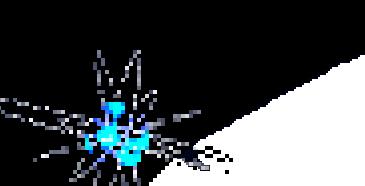


[5]EETimes. NASA Preps its Next Laser Demonstra-

29
columbia science review EDITORIAL BOARD
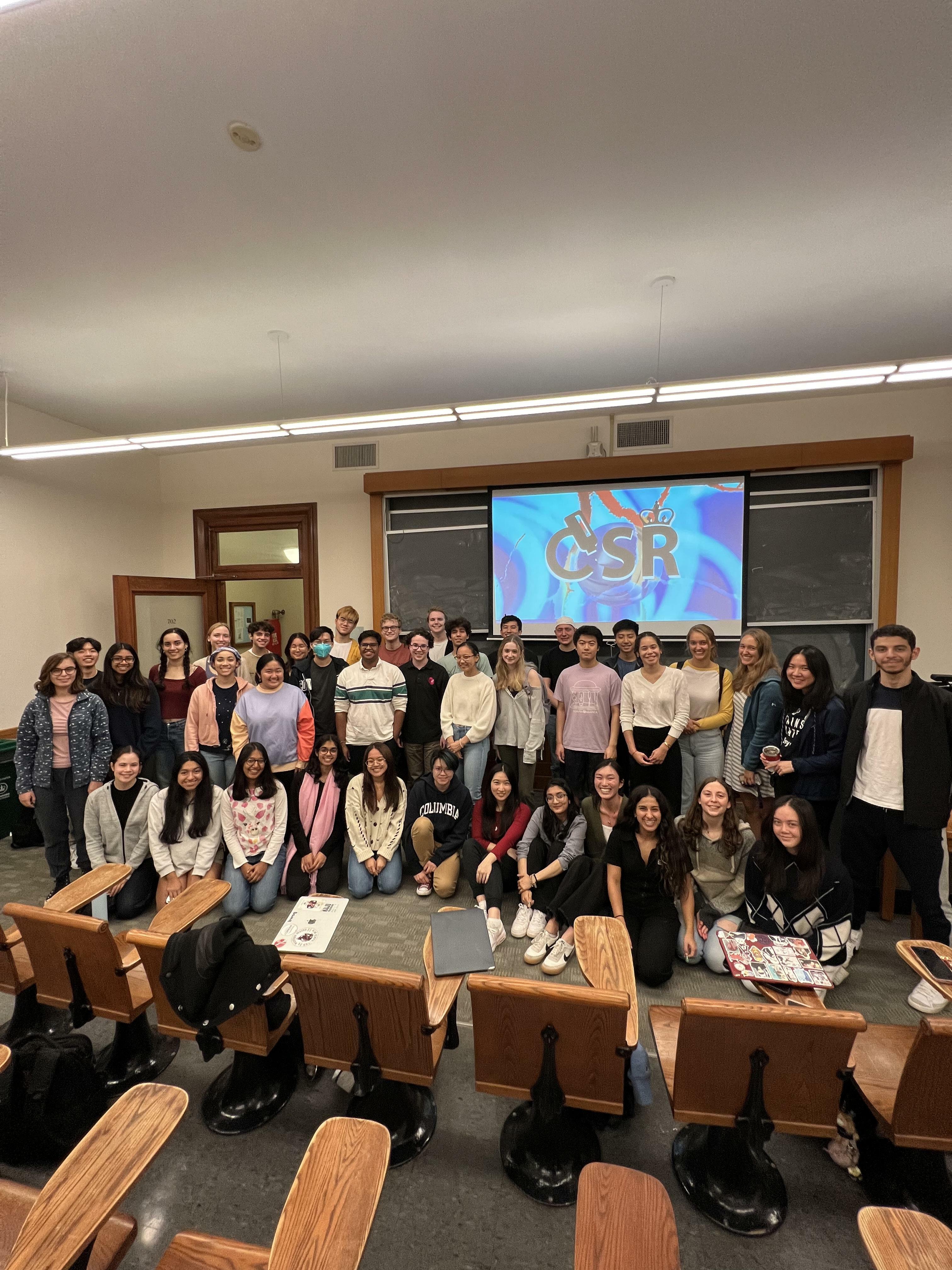
Fall 2022

































































